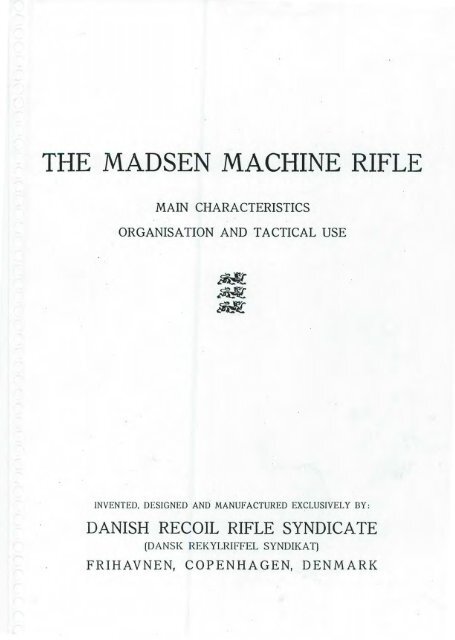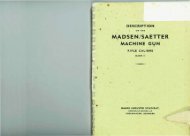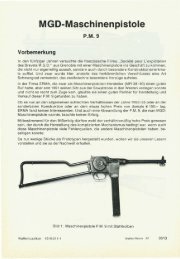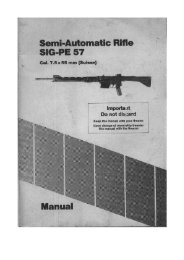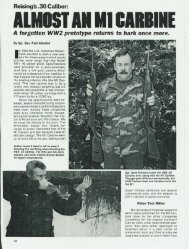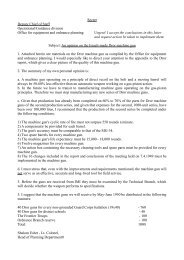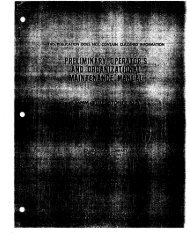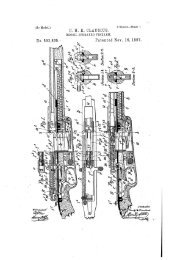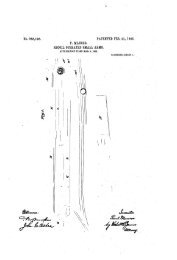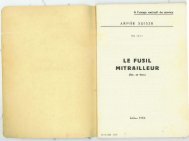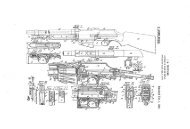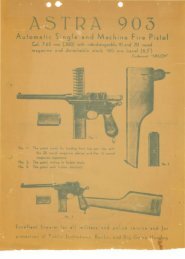THE MADSEN MACHINE RIFLE - Forgotten Weapons
THE MADSEN MACHINE RIFLE - Forgotten Weapons
THE MADSEN MACHINE RIFLE - Forgotten Weapons
Create successful ePaper yourself
Turn your PDF publications into a flip-book with our unique Google optimized e-Paper software.
<strong>THE</strong> <strong>MADSEN</strong> <strong>MACHINE</strong> <strong>RIFLE</strong><br />
MAIN CHARACTERISTICS<br />
ORGANISATION AND TACTICAL USE<br />
INVENTED, DESIGNED AND MANUFACTURED EXCLUSIVELY BY:<br />
DANISH RECOIL <strong>RIFLE</strong> SYNDICATE<br />
(DANSK REKYLRIFFEL SYNDIKAT)<br />
FRIHAVNEN, COPENHAGEN, DENMARK
<strong>MADSEN</strong> <strong>MACHINE</strong> <strong>RIFLE</strong>: (Model Alfa)<br />
Weight (without accessories) . . . 16 lbs.<br />
Firing Capacity: 10 shots per second, 400 shots per minute including time for changing magazines, 12,000 shots per<br />
hour, including time for barrel changing which operation takes 12 seconds.<br />
Also: single shots with rapidity at will up to about 100 shots per minute.<br />
"'
or on flooded, marshy or broken up grounds. The gun is used. with<br />
bayonet, almost as easily as a rifle. It can also be fired with great accuracy<br />
from a light detachable bipod that weighs 1l lbs. The Madsen<br />
M. R. therefore, can be used equally well for l.ong rang·e or accuracy<br />
firing, and for short range fighting or in a hand-to-hand struggle.<br />
ACCURACY & TRAVERSING.<br />
12<br />
The official Report of the Machine gun School, British Army m<br />
France, (1915) sums up the accuracy trials as follows:<br />
»A'Ccuracy: good«.<br />
»Traversing: extremely good«.<br />
During the trials on Salisbury Plain, August 1919, the following·<br />
results were obtained:<br />
at 200 yards: 100 o;o inside circle of 12" diameter<br />
91 Ofo » ,. ,. 8" »<br />
at 400 yards: 100 Ofo inside ,square of 1'9" X 1'4"<br />
75 Ofo » ,. ,. 0'5" x 1 '3"<br />
at 800 yards: 100 Ofo inside square of 1'11" X 2'3"<br />
75 Ofo » ,. • 1' 5" X 2'0"<br />
at 200 yards: 15 iron plates 1' X 1' shot down with 19 shots in 1 min. 18 sec.<br />
At another official trial the following results were obtained:<br />
al1.400 yards: target 50 standing skirmishers, 1 pace interval 100 single shots,<br />
1 min. 30 sec. 46 hits, 30 targets hit.<br />
at 1.000 y;,rds: target 50 standing skirmishers, 1 pace interval 272 shots rapid,<br />
1 min. 30 sec. 100 hits, 39 targets hit.<br />
Surely no other machine gun could ·obtain better results.<br />
At the School of Musketry, Hythe, (19i8), the Madsen Gun with<br />
bayonet fixed was fired from the shoulder without any support, rifleman<br />
standing as well as lying prone, 880 rounds rapi:d against an embankment<br />
at 200 yards range.<br />
The observation by the Experimental Officer is as follows:<br />
»This was carried out. Firer appeared to traverse top of' bank<br />
»with a remarkable accuracy.
Hotchkiss Guns the hot cartridge cases a.re ejeGted violently to the side,<br />
causing great inconvenience to the men near the gun.<br />
MECHANISM.<br />
The mechanism of the Madsen Machine Rifle is extremely simple<br />
and chiefly constructed on the cam-and-groove principle, which is the<br />
best existing. The bearing surfaces are long and large and slide smoothly<br />
ag·ainst ea;ch other without undue friction or violence. J ammin,q never<br />
occurs with the new model of the Gun and was practically out of question<br />
even with the older models.<br />
In the official report of the Commandant, Machine-Gun-School, British<br />
Army in France (1915) it: is laid down that the Madsen Machine<br />
Rifle:<br />
»is mechanically sound, is well constructed and not subject to<br />
»failure. I recommend this nfle strongly to your notice and su,q<br />
»gesf; that a number of them be ordered for 1:ssue to units.<br />
In the official report of the School of Musketry, Hythe, Jan. 1918,<br />
it 1s stated that:<br />
»the gun functioned corr-ectly . . . . Ther-e was little liability to<br />
»jam, and jams ar-e easily cleared. Mud in the magazine had little<br />
»effect.<br />
In the official repo;rt of H. M. S. »Excellent«, Whale Island:, it 1s<br />
stated:<br />
»By this time, the ,gun was throughly covered with ,grit and<br />
»dust. The ,gun was then loaded and fired without any trouble.<br />
»A certain amount of grit had ,got into the mechanism through<br />
»the magazine-holder, but this had no effect on the operation of<br />
»the mechanism. The ,gun was then immersed in salt water for<br />
»5 minutes with the grit still in it. On being taken out of the<br />
»water it was loaded and fired correctly.<br />
The Officer Commanding the Zululand Mounted Rifles after having<br />
used Madsen Machine Rifles (Rexer guns) in the Natal Rebellion of<br />
1906, reported inter alia, as follows:<br />
»During the time the ,guns have been m use, not one single<br />
21
»instance of' car-tr-idge .?·a:mrn'i'ng has occur--red, a, valuable pm:nt<br />
»that needs no cornment;.<br />
After 15 years' improvement, the mechanism of the Madsen Machine<br />
Rifle has in fact reached absolute perfection. Its unfailing automatie<br />
working even ui)der the most difficult Service conditions and in spite<br />
of mud, earth, sand, water, dust, etc. (within reasonable limits) is<br />
indeed one of the most. important advantages of the Madsen Machine<br />
Rifle. At a trial with the Brazilian army, one Madsen Machine Rifle<br />
fired 26.000 rounds without a single failure or stoppage. At another<br />
trial 69.000 rounds were fired from one Madsen G'un witho'ut a single<br />
stoppage or jam occur-in[!.<br />
The g;un will n.ot require any cleaning whilst in action and vill<br />
fire correctly without lubrication.<br />
HOUGH HANDLING.<br />
SAFETY.<br />
22<br />
The Madsen gun and its magazines are very strongly built and will<br />
stand the rour:hest handling on the battlefield. In the official report of<br />
th e: London District Command, May 1918, it is stated:<br />
»The gun was twice thrown ten or twelve feet up into the<br />
»air· and fell on har-d gr-ound; the magazines were lciclced and<br />
»stamped on. The g'un f"ir-ed cor-rect,ly and without any stoppage<br />
»immediately after.<br />
»No Lewis gun would have stood the rough tr-eatment to<br />
:»which both the gun and magazines wer-e subJ'ected.<br />
Similar trials were carried out many times with the same gun a.lso<br />
at the School of Musketry, Hythe, with equally good results.<br />
Immediately after the firer releases the trigger, the fire will stop<br />
and the barrel with the breech be automatically caught in its rearward<br />
position, leaving the chamber- empty. Under no conditions can there<br />
be a cartridge in the chamber when firing has stopped, and accordingly<br />
all dang·er of a misfire caused by the heat of the barrel is eliminated.
TRAINING.<br />
ln the report of the Schoo,! of Musketry, Hytihe, (1918) on the Madsen<br />
Machine Rifle, Model 1918, it is stated:<br />
»Instruction on the mechanism is ver·y eas:y to impart.<br />
In the Infantry Report from the London District Command, May,<br />
1918 it IS stated:<br />
»A Non-Commissioned Officer who had only two hours instruc<br />
»tion was able to fire the gun correctly and to strip 1't in 30 seconds.<br />
»Its simplicity from an instructional point of view appears<br />
»to be of gr·eat importance. The Company's claim that a few<br />
»days should be sufficient to train troops, who have had previous<br />
»knowledge of Machine Guns, aprwars to be justifiable.<br />
In the official Cavalry Report on the Madsen Gun (May 1918) it is<br />
laid down:<br />
»As regards the tra.ining of troops in the use of this weapo·n<br />
»its advantages are pronounced, and a considerable amount of<br />
»time can be saved. The question of stoppages is almost obliterated,<br />
»the handling of the rifle is extremely simple, and with twelve<br />
»hours' training a man would be quite efficient in the handling<br />
»of gun and mechanism, and given sufficient a.mrnunition for<br />
»training purposes, an effective shot within a week.<br />
GENERAL CONCLUSIONS.<br />
In the official British Infantry Report (May 1918) the following·<br />
conclusion is drawn:<br />
»The ·general impression produced by these trials 'LS a ve-ry<br />
»favourable one. All observers were unani·mous in the opmwn<br />
»that the Madsen Ma,chine Rille has a great advantage over the<br />
»Lewis and Hotchkiss Guns in weight, simplicity and firing effi<br />
»ciently.<br />
»Moreover the fact has been demon.strated that a su.f{?'cient<br />
»knowledge of the; gun can be acquired in a few hour-s. This am..>enr·s<br />
»to be a very important point having regard to the time and<br />
»labour necessary for the training of efficient Lewis gunners.<br />
23
'<br />
Team advancing carrying 23 wallets with 46()0 rounds of ammunition, each wallet<br />
containing 5 magazines holding 40 rounds each .<br />
..
ORGANISATION AND TACTICAL USE<br />
The Madsen Machine Rifle, is used with great advantage by the<br />
Infantry, Cavalry, Field Artillery (for defence of the batt,eries) Supply<br />
Columns (on motor lorries) and also by the Navy (for landing parties<br />
and light craft). Special Models of the Madsen· Gun are designed fo,r use<br />
in Aeroplanes and in Tanks.<br />
. A COMPLETE TEAM<br />
I<br />
INFANTRY<br />
for one Madsen Machine Rifle with ammunition consists of a Rifleman<br />
(No. 1) three Ammunition Carriers (No. 2, 3 & 4). In open warfare<br />
a man (No. 5) ·may be added leading a pack-mule or pony with ammunition.<br />
The gun itself is served entirely by one man. The Carriers<br />
are armed with powerful, long range, automatic pist10ls.<br />
FIGHTING POWER . .<br />
If these 5 men were armed with 5 ordinary rifles they could fire<br />
about 40 rounds per minute on the average. Armed with 1 Madsen Machine<br />
Rifle with ammunition they can fire 400 rounds per minute. The<br />
fighting power of each such team is therefore increased ten tim.es,<br />
without in any way diminishing· their mobility and independence.<br />
AMMUNITION<br />
is carried in light wallets of leather or web each holding 5 magazines<br />
with 200 rounds. It is su.ggested to have 20 wallets with 100 magazines<br />
35
Each ammunition Carrier (No. 2, 3, 4 & .5}:<br />
Automatic pbtol. wilh ammunition.<br />
2 water bags.<br />
Belt and leather-yoke.<br />
No. 2 carries 2 small pouches with spare parts and tools, second barrel-and-breech<br />
in cooling sheath, cleaning-rod.<br />
The corporal commanding a section of 2 gun-teams carries:<br />
Automatic pistol with ammunition, 1 smalJ pouch with spare-parts and tools<br />
(common for the 2 guns) and 1 pouch with an oil-can.<br />
The Pack-Mule:<br />
Bridle.<br />
Pack-saddle for 10 wallets (50 magazines with 2000 rounds).<br />
INCORPORATION.<br />
No new unit will have o be created: only a certain number of Infantry<br />
Sections should be re-armed as above mentioned, and thus converted<br />
into machine rifle Sections, each Section (8 men) forming complete<br />
teams for 2 Madsen Machine Rifles with ammunition.<br />
AS AN EXAMPLE,<br />
it is suggested to provide:<br />
Each Infantry Platoon with 2 Machine Rifle Sections (4 M. R's and 16 men) which<br />
could either remain so distributed, or<br />
Each Infantry Company could unite its 8 M. R. Sections forming 1 Machine Rifle Platoon<br />
(16 M. R's and 64 men)<br />
Each Infantry Battalion could again unite its 4 M. R. Platoons forming 1 Machine<br />
Rifle Company (64 M. R's and 256 men)<br />
Each Infantry Brigade could again unite its 4 M. R. Companies forming 1 Machine<br />
Rifle Battalion (256 M. R';=; and 1.024 men).<br />
In this way the commanders of Brigades, Battalions and Companies<br />
could conveniently concentrate or distribute their Machine Rifles as<br />
the tactical situation may require, without spEtting up any of the r egular<br />
Machine Rifle Units.<br />
Such Machine Rilfe Units are as mobile as ordinary Infantry; they<br />
37
can advance by rushes at top spc·cd, clear obstacles on their way, :take<br />
up positions everywhere and. instantly open fire. The fact that the<br />
Madsen Gun can be fired without SUJ.lport in standing position enables<br />
the Machine Rifle Units to fight under conditions where heavy machine<br />
guns are useless: in close quarter fighting, on flooded, marshy or broken<br />
up ground when fording rivers, when penetrating into buildings an·d<br />
ruins or into .the ennemy's trenches and dugouts. Further, the Machine<br />
Rifle Units can car.ry out storming assaults, using the Madsen Guns<br />
with their bayonets for the final hand-to-hand strugg-le.<br />
TACTICAL USE.<br />
38<br />
The Madsen Ma.chine Rifle should be used m accordance with its<br />
particular characteristics viz:<br />
(1) Its firing· efficiency and .endurance,. almost equal to that of the<br />
Vickers Gun (76 lbs.O concentrated in a weapon weighing 16 .lbs., and so<br />
well belanced that it can be fired from the shoulder without support and<br />
used with bayonet almost as easily a.s a rifle.<br />
(2) Its portability and handiness even when the barrel is hot, its mechanism<br />
and casing remaining· cold.<br />
(3) The rapidity (12 seconds) and ease with which the barrel is changed<br />
in any 11osition of the rifleman and even when he is running.<br />
(4) Its ability to keep up continuous rapid firing for an unlimited time<br />
400 rounds per minute and up to 12.000 rounds per hour, including- the<br />
time for barrel changing between the series.<br />
(5) The simplicity and perfect working of its mechanism in spite of<br />
mud, water, sand, etc. o'<br />
(6) No adjustment of the return spring nor cleaning and oiling· of any<br />
part when the gun is in action.<br />
(7) The remarlmble streng·th of the gun and magazines that enables<br />
them to stand the roughest handling· on the battlefield.<br />
(8) Lighter magazines than the Lewis Mag·azines: 113 lbs. saved on the<br />
mag-azines' for 10.000 rounds.<br />
The Madsen Guns, therefore, will enormously increase the fighting<br />
strength of all Infantry Units, not only for defence, but particularly<br />
for attack.
In the Offensive, the Madsen Machine Rifles should be used concentrated<br />
in great number in the firsb attacking: wave,. and on the<br />
flanks of the atta-cking Units enabling the lnf'antry to maintain the<br />
superioty of' f'ire with their own arms f'rom the critical 'moment when<br />
the artillery can no long.er support them by overhead f'ire. They should<br />
be followed by other waves of Bombers, Riflemen and »Moppers-Up«.<br />
Every attacki.ng Brigade can concentrate its 4 MachiiJle-Rifle Companies<br />
in the front line, with their 256 Madsen Guns deployed on a front<br />
of some 1.000 yards width. These can develop a fire of some 100.000<br />
rounds. per minute, with overwhelming effect, agai.nst the enemy's trenches<br />
and their supports and against the counter-attacking reserves.<br />
In this way, the Infantry will be cub1e to break through one line<br />
after another, and penetrate deep into the Enemy's defensive area, the<br />
Machine-Rifles breaking their organised resistance, the succeeding waves<br />
bringing up fresh ammunition, the Bombers and »Mappers Up« clearing<br />
the trenches that are passed.<br />
The Machine Rifl.e Units a:re also admirably suited for the capture<br />
of fortiHed villages and for holding newly won positions until stronger<br />
reinforcements of Infantry and Artillery can be brought up.<br />
No other Machine Gun can rival the Madsen Machine Rifle in the<br />
Attack, because this ; g·un alone combines lightness and handinet;s with<br />
a tremendous firing efficiency and .Perfect working under severe battlefield<br />
conditions.<br />
The Machine-guns now in use with the British Infantry and Cavalry<br />
do not combine these qualities. The Vickers Gun is capable of keeping<br />
up contJinuous .rapid fire but its weight with the indispensable mounting<br />
is 76 lbs. and so it is too hea1Jy ilQ be brought over the top and rushed<br />
forward with the attacking Infantry. It can only fire from its mounting<br />
an:d is m:eless in a. hand-to-hand struggle. "<br />
The Lewis and Hotchkiss Guns possess neither of these essential<br />
qualities. They are comparatively heavy (28 lbs. i. e. nearly double<br />
the weight of the Madsen Gun) and very difficult to handle after firing,<br />
the entire gun bei1ng overheated. They can keep up rapid fire only for<br />
a few minutes with long intermittent pauses to cool down. Their automatic<br />
working is bad and unreliabLe under severe battlefield conditions.<br />
They are useless in a hand-to_:hand stJruggle.<br />
Even the Lewis Gun Company admits these shortcomings of the<br />
Lewis Gun. In their published bookliet: »Lewis Automatic Machine Guns,<br />
the Vital Factor in the European War« (6th page), it is said:<br />
»In the eaTly days the characteristics of the gun were not<br />
».thoroughly understood by us, with the Tesult that the gun was<br />
39
40<br />
»submitted to tests which it has never been intended to with<br />
»stand. For instance, it was f"ired con tin o us l y until it becarne<br />
»red hot and jarnrned,<br />
and furthe1r in the »Instrukttion on the Lewis Automatic Gun « pa.ge 64:<br />
»The gun is suited only for short bursts of rapid fire and<br />
»should only be used when an excellent ·target is offered.<br />
In the Defensiv the 11a·dsen Machine Rifles possess the advantag·e of<br />
paramount importance - that each gun keep up continuous rapid fire<br />
for an unlimited time at the rate of 12.000 rounds per hour, so that a<br />
defensive position held by a great number of Madsen Ma1chine Rifles<br />
(there c_an be one for every yard) cannot be broken or taken by any<br />
Infantry attack, however long the onrush continues and however dense<br />
the attacking masses may be.<br />
Such attacks could only succeed against positions held by Lewis and<br />
Hotchkiss guns and ordinary rifles, which weapons afte.rr a few minutes,<br />
reach their 1imits of fire and fall out of action.<br />
In defence also the lightness and handiness of the Madsen Gun is<br />
of great importance, because the Infantry may be called upon to change<br />
position or to counter-attack or retire at any moment.<br />
During the preceding Artillery bombrurdment, the Madsen Guns can<br />
be held under cover in dug-outs, etc. and yet be.. thrown on to the parapet<br />
as quickly as ordinary rifles, howeve1r demolished the parapet may be.<br />
The Vickers Gun is an admirable weapon for maintaining sustained<br />
fire from a defensive pos#ion, but it is too heavy to be instantly brought<br />
into action if it were held under cover during the bombardment, and<br />
must frequently be abandoned in retreat.<br />
Should the enemy penetrate into our defensive system, then the light,<br />
short and handy Madsen Gun is an admirable weapon for fighting· in<br />
the trenches, round traverses', barricades and dug-outs to prevent the<br />
enemy's furthe:t;" progress.<br />
II<br />
CAVALRY<br />
For the Cavalry, the Madsen Machine Rifle is the ideal weapon<br />
because it increases tremendously their fighting power without impeding<br />
mobility and independence. The g-reat superiority of the Madsen
. :
'I i<br />
l ' I<br />
. /t<br />
...... ' \
, ;
III<br />
FIELD ARTILLERY<br />
The Madsen Machine Rifle may be used with great advantage fo·r<br />
the defence of field batteries whethelr on the march or in position<br />
against sudden attacks by hostile troops or air-craft. Each battery should<br />
be provided with a sufficient number of these rifles (for instance 8)<br />
to defend all echelons or£ the battery in position, viz: the gun line, the<br />
isolated limbers and teams, the reserve wagons and teams, and the<br />
fire-control station. For this purpose,, four of the machine rifles should<br />
be carried on the wagon bodies, two on the limbers and t1wo on horsebacks.<br />
The Madsen Machine Rifle can easily be served in case of attack by<br />
the artillerymen who otherwise serve the wagons· or limbers. In this<br />
way, the Field Artillery will be more effectively defended and will no<br />
longer need escorts of Cavalry or covering detachments of Infantry<br />
for protection.<br />
IV<br />
WITH <strong>THE</strong> NAVY<br />
The Madsen Machine Rifle is admirably suited for Landing parties<br />
which might be exclusively armeid with these weapons. Warships can<br />
only land compa:ratively few men whilst their task may be of great importance.<br />
It is, therefore, essential that the Landing parties should<br />
possess the greatest possible fighting power. What is said above for<br />
the Infantry equally well applies to Marine Infantry or Landing Parties<br />
of Sailors who could derive the same advantages from these light and<br />
powerful weapons.<br />
Further Madsen Machine Rifles may be successfully used as an auxiliary<br />
armament for destroyers, patrol..:boats, submarines, mine-sweepetrs<br />
and other light craft, for rive,r-expeditions and for Anti-Aircraf't Service.<br />
v<br />
WITH <strong>THE</strong> TANI


